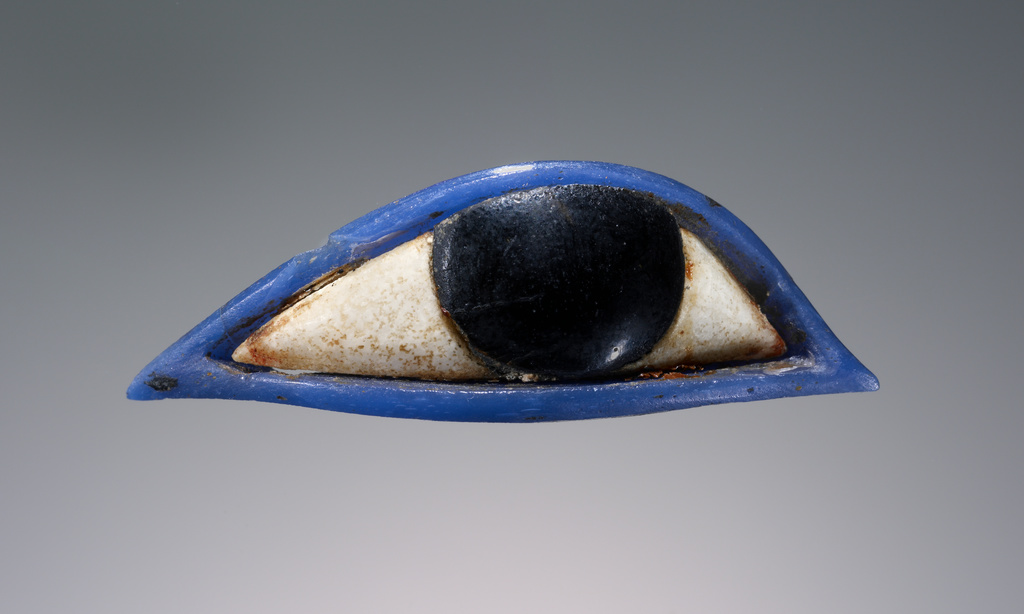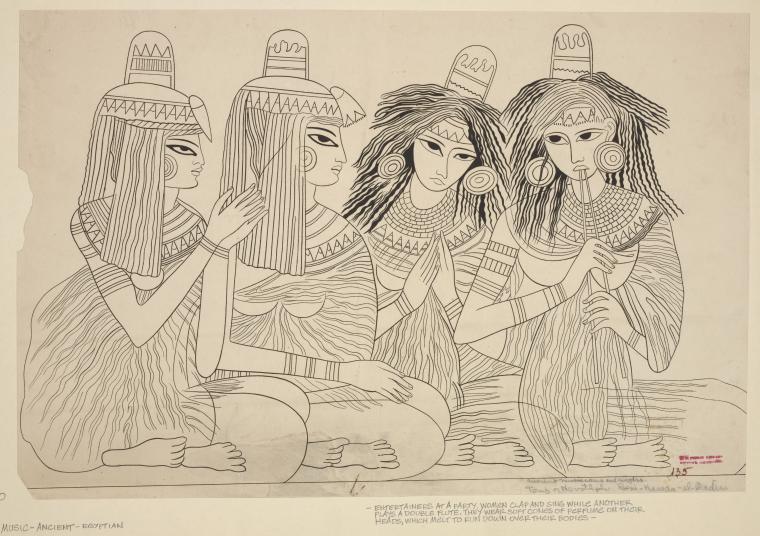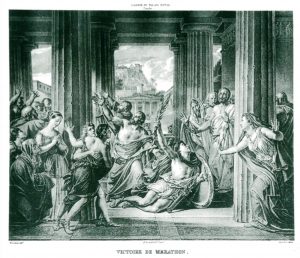Did you know that the existence of beauty products dates all the way back to 4,000 B.C.E.? In ancient Egypt, eye cosmetics were kept in cylindrical containers made out of either stone, ceramics, or wood for preservation.1 When they were first created, these eye products were used by their people for adornment reasons. However, as time went on, Egyptians developed kohl – a paste which was made up of mainly galena, a mineral form of lead sulfide. They realized this could be used for medicinal purposes as well—causing the quality and quantity of eye cosmetics throughout Egypt to increase drastically.

By 2,000 B.C.E. the accustomed eye cosmetic known as kohl was advanced drastically. Scientists have recently used a method called wet chemistry to determine this evolution.1 In addition to kohl being used to add personal sense of style to their faces, it was also a new and quite interesting source of protection. Therefore, both men and women took advantage of kohl.
At first, kohl was not used in the way we use eyeshadow today, but more like eyeliner. An extremely thick ring of eyeliner surrounded the whole eye.3 It also was not only used for beautifying purposes, but also for protection.4 Since the first kohl creation was a very dark black shade, it reflected light off of the dark pigment, protecting the eyes from harmful sun rays. Kohl was used to surround the eyes of both men and women. Simultaneously, kohl’s main ingredient, galena, was known as a disinfectant among the people of Egypt. This led the ancient Egyptian physicians to lean toward kohl as a prescribed drug for various diagnosed eye diseases.1 The Egyptians didn’t necessarily benefit aesthetically through obtaining a whole color palette of kohl. The medicinal side was extremely influential. The galena was mixed with other ingredients, including water, to create pastes of various tones. Among the most popular of these tones was a dark black and a very vibrant green.6
The deep, dark black kohl was created by the mixing of galena and soot. Soot is an extremely flaky substance that contains high amounts of carbon, which gave it the jet-black look.7 The green kohl on the other hand was made up of galena and malachite, a green pigmented rock. This rock was pummeled and mixed with the galena and water, creating a thick, vibrantly colored paste.8

Although the people of Egypt don’t use kohl the way they used to in 4,000 B.C.E., we can most certainly conclude that where we are today in the cosmetic industry would have definitely been delayed if it weren’t for the Egyptians. Their exploration of cosmetics is the base of our creams, exfoliators, and enhancers that exist on the shelves today.8
- P. Walter, et. al., “Making Make-Up in Ancient Egypt,” Nature 397, no. 6719 (Feb 11, 1999): 483-484. ↵
- P. Walter, et. al., “Making Make-Up in Ancient Egypt,” Nature 397, no. 6719 (Feb 11, 1999): 483-484. ↵
- Encyclopedia of Clothing and Fashion, 2005, s.v. “Western Cosmetics,” by Kathy Peiss. ↵
- P. Walter, et. al., “Making Make-Up in Ancient Egypt,” Nature 397, no. 6719 (Feb 11, 1999):: 483-484. ↵
- P. Walter, et. al., “Making Make-Up in Ancient Egypt,” Nature 397, no. 6719 (Feb 11, 1999): 483-484. ↵
- F.T. Walton, “My Lady’s Toilet,” Greece & Rome 15, no. 44 (May 1946): 69. ↵
- Marguerite Johnson, Ovid on Cosmetics: Medicamina Faciei Femineae and Related Texts (United Kingdom: Bloomsbury Publishing, 2016): 11. ↵
- Zoe Diana Draelos, “Overview: cosmetics and the art of adornment,” Dermatologic Therapy 14, No. 3 (September 2001): 175-177. ↵
- Zoe Diana Draelos, “Overview: cosmetics and the art of adornment,” Dermatologic Therapy 14, No. 3 (September 2001): 175-177. ↵



57 comments
Alexandra Cantu
Its fascinating how the birth of makeup began and how it was used as medicine and protection for both men and women. I always knew Egyptians wore make up but I never knew from what its not like they had a Kat Von D eyeliner ready for use they had kohl. I really enjoyed the different ingredients used to make certain colors that was really cool.
Julian Aguero
Great article I wonder how they knew that the Eye makeup was beneficial to them. Interesting that men and women were both using this make up. I’ve never heard has make up being used for protection that is very interesting. Its pretty fascinating that a beauty product was also used as medicine. I wish I could see how the people of this timed looked and dressed it must have truly a sight to see. Very informative article I really enjoyed the information.
Destiny Flores
The dark eyeliner is so iconic for the Egyptian culture. It’s because it’s so common and surrounds everything about its history, its overlooked. I didn’t know the true meaning behind the eye-makeup and how it came to be or that it had other useful hacks such as medicinal and protecting benefits. Very interesting and informational! It would have been nice if it included if the eye-makeup varied among classes or sectors of the cast system.
Arianna Kennet
Well this was definitely something new I learnt. Makeup used to be medicine? Kohl used as a form of protection against sun rays? Men wore makeup commonly? Wow. This article has opened my eyes to the history of makeup and the different uses of it which I wouldn’t have imagined. It’s funny too because I know of the makeup brand Kohl and I wonder if they got their name based on the history of Kohl.
Constancia Tijerina
As a person who wears makeup themselves, it is refreshing to know how the idea of makeup and its advantages started out. I would have never though that the method of the ancient Egyptians of wearing makeup was a form of medical and health hygiene to protect the men and women’s eyes from the harmful rays of the sun beating down on them constantly. This article over all was a refreshing and thoughtful read of how people could even invent ideas that can, not only benefit you in your health, but can also benefit you in your appearance.
Karla Chavana
This Article was not only articulate but interesting to read ;the article shed a lot of light into the beginnings of what now is one of the biggest idolized and industrialized businesses of the world. The thoughtfulness and knowledge used for their protection and adornment are so peculiar, and it makes me wonder how this gained popularity throughout. Next time is use skin care or makes up similar to their practices , I will always have this to think about , and the Egyptians to thank.
Deanna Lummus
This is so interesting to learn about. I like how it really started off as a form of medicine. I always thought Egyptians wore makeup but I wasn’t sure. I knew they used paint looking stuff to paint themselves but I didn’t know they used it to look good as well. This is really interesting because we still use kohl eyeliner today. I use it every day almost!
Clarissa Bustamante
This article is such a great one. Also a very unique topic; it was very different from all the other ones I have read. It was cool to learn about the beginnings of things that many people use on the daily and how long ago it was being used. Awesome how there was many times when both men and women were seen wearing a specific eye wear that protected them from the harmful sun rays. It’s pretty crazy how the Egyptians came up with all of these unique tools.
Teresa Valdez
This article made the influence of the ancient Egyptian on modern day cosmetics very clear. The medicinal uses of kohl are very fascinating. I had no idea that this was an encouragement for both men and women to wear eye makeup. The article is very well researched. I imagine that I would be very frustrated trying to put on this type of makeup. Don’t be afraid to use pronouns in the article. It is very clear from the first couple sentences that the main subject is the use of kohl. Great job!
Andrea Chavez
This article was very different from the ones I usually read, it is impressive how fashion, beliefs, and medicine can all be integrated in one single thing. I really thought that the kohl was only used as makeup and to find out that it worked as a protection was really impressive. But what was mind blowing is the fact that it could be used as medicine, now I am just curious if it would actually work against their diseases.